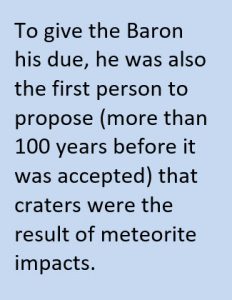
The week of July 31 – August 6 takes us from Day 8 to Day 14. This week we will highlight the so called “Lunar City,” viewable on Monday night, but the lighting has to be perfect, so if you’re not able to make it out, make a point of coming back when the terminator is just a little bit west of the crater Schröter (around 9° W).
 Lunar City: [NW/J9] Once upon a time there was a famous lunar observer and selenographer1 by the name of Baron von Gruithuisen (GROOT.hoo.zen). The Baron was famous for two things: 1) He was a good observer and selenographer (three lunar formations are named after him), and 2) He had a wild and fanciful imagination. He wrote an entire book detailing his discovery of what he believed to be the ruins of a magnificent lunar city, complete with “colossal buildings and gigantic ramparts” and other evidence of “Moon-dwellers.” In spite of a strong penchant for science, he tended to live in a land of make-believe.
Lunar City: [NW/J9] Once upon a time there was a famous lunar observer and selenographer1 by the name of Baron von Gruithuisen (GROOT.hoo.zen). The Baron was famous for two things: 1) He was a good observer and selenographer (three lunar formations are named after him), and 2) He had a wild and fanciful imagination. He wrote an entire book detailing his discovery of what he believed to be the ruins of a magnificent lunar city, complete with “colossal buildings and gigantic ramparts” and other evidence of “Moon-dwellers.” In spite of a strong penchant for science, he tended to live in a land of make-believe.
 Tonight you have an opportunity to visit the baron’s lunar city. Take a deep breath, make yourself temporarily credulous, throw your telescope (and your mind) a little out of focus, and scan the mountain region about 60 miles north of the ruined crater Schröter (it’s about 20 miles in diameter). The southern boundary of the lunar city begins at the crater Schröter W and continues north for a short distance. To get hints of the city, the terminator must be very close.
Tonight you have an opportunity to visit the baron’s lunar city. Take a deep breath, make yourself temporarily credulous, throw your telescope (and your mind) a little out of focus, and scan the mountain region about 60 miles north of the ruined crater Schröter (it’s about 20 miles in diameter). The southern boundary of the lunar city begins at the crater Schröter W and continues north for a short distance. To get hints of the city, the terminator must be very close.
OF ADDITIONAL INTEREST IN SPACE THE WEEK OF JULY 31 – AUGUST 6:
Eyesight test: If you are far enough south that you can see most of Scorpius, then take a look at Mu Scorpii around 10:00 PM (it’s the third star down from Antares). With clear, steady skies, it is possible to make it out as a double star with your naked eyes. They are at magnitudes 3.0 and 3.5 and are separated by 5’ 48” of arc.
1 Selenography: the study of the physical features of the Moon.
======================
It is highly recommended that you get a copy of Sky and Telescope’s Field Map of the Moon, the very finest Moon map available for use at the telescope. It is available for $10.95 at www.skyandtelescope.com and on Amazon. All features mentioned in this blog will be keyed to the grid on the Field Map and will look like this: Plato: [NW/D9]
Credits:
Courtesy of Gray Photography of Corpus Christi, Texas
Lunar photos: NASA / USGS / BMDO / LROC / ASU / DLR / LOLA / Moon Globe. Used by permission
- Rupes Cauchy: A Best Known Fault on the Moon - July 22, 2024
- Moon Crater Schickard – Crater Floor has Stripes - July 15, 2024
- Moon Craters Langrenus and Vandelinus - July 8, 2024